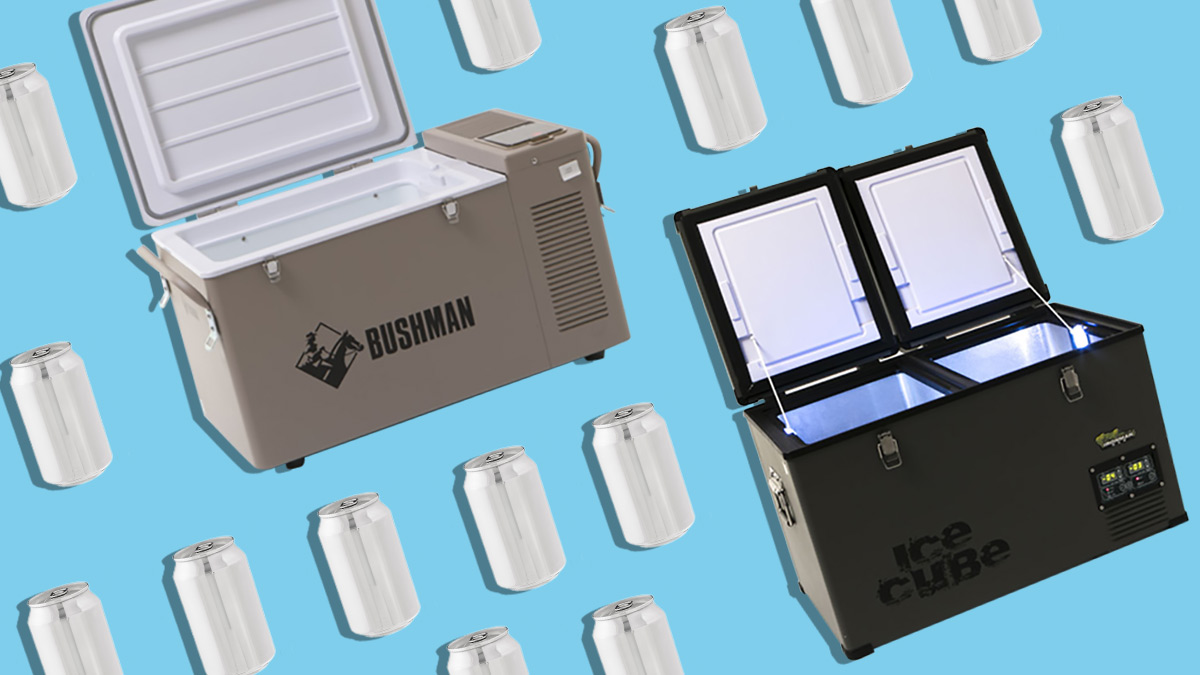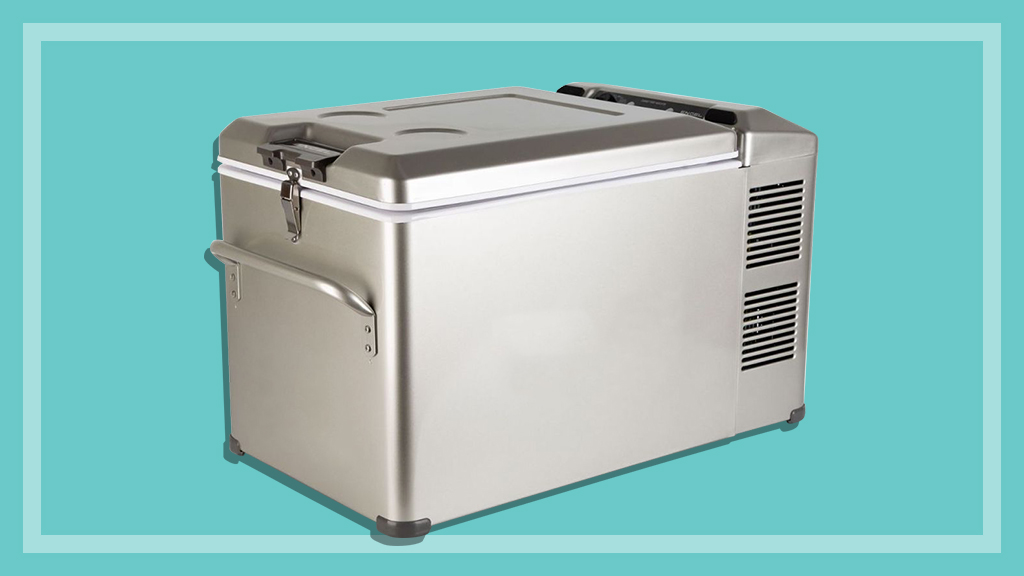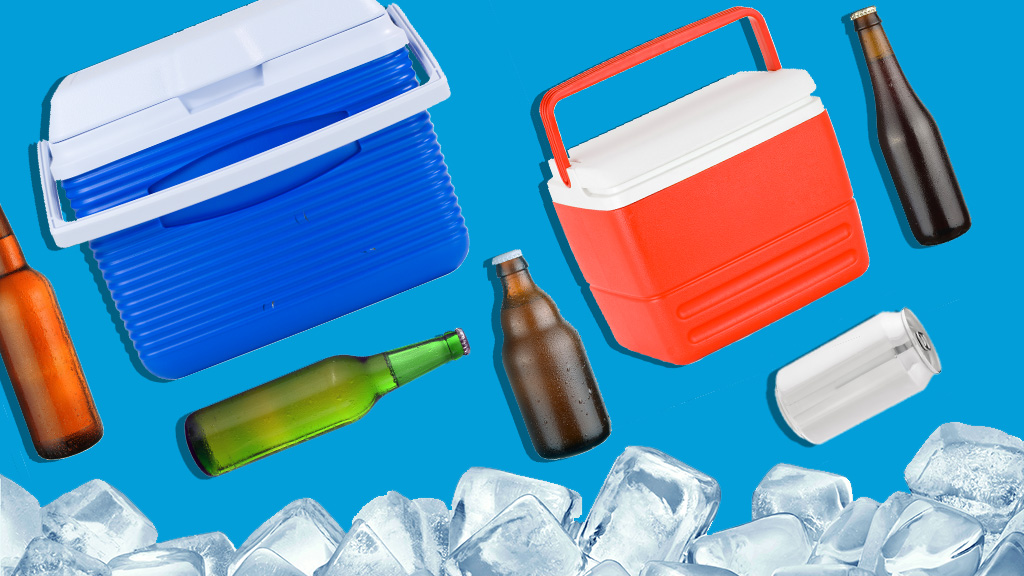How to buy the best portable fridge
Compressor, absorption or thermoelectric – which portable fridge is best?
Last updated: 20 Sep 2021
A portable camping fridge is a powered mobile cooling system that typically runs off your car’s 12-volt electrical system to keep your food and drinks cold (or frozen) indefinitely. It’s more expensive than a cooler or esky, but you’ll never need to worry about replenishing your ice again.
On this page:
Caravanning around Australia calls for a larger capacity and more features than shorter camping adventures where compactness and manoeuvrability may be more important. How many people will your portable fridge need to service? Will it stay in a vehicle, be used 24/7 as an overflow fridge at home, or only be switched on a couple of times a year?
What size portable fridge do you need?
Large fridges mean greater capacity, but higher current draw, and they’ll take up more space in your car. When choosing a fridge, measure the space inside your vehicle to make sure it will fit, including the additional height of any mounting hardware or slides. Also consider clearance for any vents and make sure you’ll have enough room to open the lid.
Large fridges can also be heavy – with a whole family plus gear already onboard, a fully loaded fridge could push your car over its gross vehicle mass (GVM).
Sizes are listed in litres, but this can be hard to visualise so we’ve included a universally recognised unit of measure – cans of drink.
25L & under (27 cans)
Essentially a powered cooler, these compact fridges are suitable for keeping lunch cold in a work truck for you and your offsider. They’re also a good option if you need to keep medicines refrigerated and close to hand.
35L (47 cans)
Ideal for a weekend away for two, or a whole week if you’re flying solo.
40L (60 cans)
The most common or ‘standard’ size, 40L fridges are great for two or three people for a long weekend.
50L (72 cans)
Suitable for a whole week adventure for two, or a long weekend for a family.
60–65L (106 cans)
A good size fridge for a family of five, or providing sustenance for your sporting team. There’s plenty of room to keep the team’s half-time oranges on ice, but consider the space it takes up in your vehicle, and the weight.
80L+ (120 cans)
Plenty of space for a week away with a big group, but size and weight may be a serious consideration. You could be better off sharing the load between smaller fridges and separate vehicles.
Expansion inserts are also available for some fridges, clipping onto the top for additional capacity when you need it.
What types of camping fridges are there?
Two-way fridges run on 12-volt or mains electricity, while three-way fridges can run on either electricity or gas. So which is better?
Two-way (compressor) portable fridges
Two-way fridges use the same compressor technology as your home fridge, though they’re designed to run on your car or truck’s 12- or 24-volt battery as well as mains electricity. They’re best for most applications because they’re designed to run off your car’s electrical system without drawing too much current, but can be switched to 240 volts in powered campground sites or in your home.
Unlike gas fridges, compressor models mean regular battery charging so they may not be the best choice for a month in situ, but they’ll tick along happily with a small solar panel setup.
Pros
- Good performance, even in hot cars and high ambient temperatures.
- Some can double as freezers.
- Work on uneven terrain or inclines.
- Can be run from a solar panel for out-of-vehicle use.
- Designed for efficient, low current draw running off your car battery.
Cons
- Setting a consistent temperature when ambient temperatures change can be tricky.
- Compressor noise may be noticeable in quiet campsites.
- Batteries must be charged regularly or your fridge will stop.
- If running off solar, it will turn off overnight.
- AC adaptors may need to be purchased separately.
Three-way (absorption) or gas portable fridges
Three-way fridges run on LPG as well as 12, 24 or 240 volts, and use gas flow heat exchangers not compressors. They’re quiet, but they don’t perform as well as compressor fridges, and must be kept level to operate.
Three-ways come into their own if you’re spending a long time in a remote location as one LPG cylinder can keep your fridge frosty for weeks – well beyond the capacity of a battery setup.
Pros
- The most versatile in terms of power sources.
- Run for several weeks on a single gas fill.
- You may not need a complicated dual-battery system.
- Almost silent.
Cons
- Must be level to operate, so not suited to constantly moving around.
- Inefficient when running on 12 volts and will rapidly drain batteries.
- Require good ventilation, so not ideal for tightly sealed caravans.
- Don’t allow you to set a temperature, but instead will cool to a certain amount below ambient. Fine for mild weather, but not for temperature extremes.
- Don’t perform as well as compressor fridges.
What about thermoelectric portable fridges?
Thermoelectric fridges don’t cool as well as other types and draw substantially more current. We’ve tested these in the past and found none could maintain safe food temperatures in anything but the mildest conditions, so they’re only suitable for keeping pre-chilled drinks cool on the way to weekend sports or on a short drive home from the shops.
How much do portable fridges cost?
Portable camping fridges aren’t cheap – expect to pay around $800–2000 for a 40–55L two-way, or $350–1300 for a three-way fridge.
Remember to factor in the cost of accessories like covers, mounting hardware, dual battery systems and other vehicle modifications to help you get the most out of your fridge.
Fridge, freezer, or both? Dual zone portable fridges
- If you’re just keeping your lunch cold then you won’t need freezer capability, but it’s essential if you’re away for more than a day or two.
- Dual-compartment fridges give you the luxury of a fridge and freezer in one and are the most convenient.
- Some clever single-compartment fridges can also do double duty by using a baffle between frozen items on the bottom and fresh food on the top. While not as convenient, you’ll have more space overall as there’s no dividing walls.
- You can also team a single compartment model with an esky or cooler for the same effect by freezing ice bricks in the fridge overnight to keep drinks cold in the cooler the next day.
Portable fridge features to look for
Low current drain
Look for a portable fridge with low current draw, especially when running on 12 volts. This is a direct indication of how long your battery will last and how long your fridge will run for at your campsite, or in a parked vehicle. Five amps is quite high and one amp is quite low. Remember, the temperature inside a vehicle can climb rapidly, so your fridge will be working extra hard if you’re parked in the sun with the windows up. If you’re using your portable camping fridge as a freezer, then your current draw will also be higher than when using it as a fridge.
Battery protection
A fridge that shuts down when the battery’s struggling could save you from being stranded, especially if you’re running it from your starting battery – look for a model that cuts out at a fairly high voltage to keep your battery from going flat.
Look for fridges with variable protection. Some fridges are set to cut out at a very low voltage (usually 9.5V) to protect the compressor, but this won’t help your battery.
Deep cycling a regular car battery by using a portable fridge can reduce its life considerably (and leave you stranded), so battery protection can reduce the risk of damaging yours. Better yet, you may want to install a dual-battery system (with a battery designed for deep cycling) for regular fridge use.
If you’ll use your fridge at home then consider its impact on your electricity bill and look for an energy-efficient model. Portable fridges don’t require an energy star rating, and they’re mainly designed for 12-volt use, so even though they’re small they may use as much power as a full-sized fridge. Consider a larger primary fridge instead and save the portable fridge for weekends away.
12-volt connector
Check your fridge has the correct connector for your vehicle. Many portable fridges come with a cigarette lighter plug to fit your vehicle’s accessory socket, but these plugs aren’t ideal for high current draw applications like fridges. They can even unplug when you hit a bump, turning your fridge off completely.
Some fridges also come with a variety of connectors to suit power sources that may already be in your vehicle. An Anderson type plug is ideal as they’re designed for high current draw and connect very securely, but you may need to have one installed.
Mounting hardware
Robust mounting hardware is essential to prevent your fridge tipping over on sharp corners or becoming a projectile in an accident. Look for sturdy mounting points to keep your fridge in place, and make sure there’s corresponding tie-down points in your vehicle.
If you take your outdoor adventuring seriously (let’s face it, if you’re buying a portable fridge then you do), then you may want a dedicated mounting kit, and there’s a variety of OEM and aftermarket mounting kits available for most fridges.
Make sure kits are compatible with both your fridge and vehicle, and that it’s easy to attach and remove your fridge when you get home or into camp.
Portable fridge slides
A fridge slide can make accessing fridges easier, and a drop slide makes it an absolute breeze – especially if your 4×4 has been lifted. You could also consider shock-minimisation options such as a foam base.
Adequate insulation
Look for a fridge with thick walls and insulation as this will generally mean better efficiency and less load on your compressor, an they’ll use less power. Also consider outer casing materials – metal is durable but conducts heat more readily than plastic, while fibreglass offers the best insulation. Optional thermal covers provide additional insulation, and provide a level of protection against bumps, scratches and dents from other things in your car.
Thermostat and thermometer
Portable camping fridges, by their nature, are exposed to a much wider range of ambient temperatures than the fridge in your kitchen, and changes in ambient temperatures may mean the internal temperature of your fridge can vary. An integrated thermometer makes it easy to monitor the internal temperature of your fridge without needing to constantly open the lid, and an adjustable thermostat means you can adjust it to maintain optimum temperatures. A thermostat that lets you dial the temperature down to -18°C means you can use it as either a fridge or a freezer, so it’s much more versatile.
Adequate temperature range
Having a thermostat and thermometer are important, but what temperature should you set your fridge to? Most portable fridges have a temperature range of around 10°C to -18°C, so there are plenty of options. Like your kitchen fridge, if you’re using your fridge for fresh foods you should aim for a temperature of around 3°C, but you should aim for around -15°C for freezer use.
Drain plug
A removable bung in the bottom of your fridge, like the ones in many coolers, makes cleaning easy. Unlike coolers, you won’t need to drain away buckets and buckets of melted ice, but it does mean you can rinse out your fridge more easily without the need to tip it over. Look for a bung that remains attached to the fridge so you’ll be less likely to lose it.
Durable construction
Your fridge needs to be able to withstand the rigours you’re going to subject it to, so look for durable construction, strong hinges and tough casings. A quality fridge should be able to take the weight of someone standing on it.
Portable fridges are also made with a variety of casing materials, so consider what’s right for your application – metal is tough and suitable for heavy duty applications, plastic can flex a little so it’s a good choice for touring, and fibreglass is strong and impervious to corrosion, so it’s ideal for marine applications. Chances are your fridge is going to get knocked around and battered in the back of your car, so if aesthetics are important to you then avoid materials and finishes that will highlight dents and scratches, like polished metal.
Your portable fridge will also be more exposed to the sun than the fridge in your kitchen, and UV rays sun can make plastic brittle or cause warping – a particular issue with plastic lids.
Compressor type
The compressor is the heart of your fridge, so choosing a fridge with a good one should keep you in business for many years. Look for portable fridges with name-brand compressors like SECOP (Danfoss), Sawa, Fuji or Waeco.
Vents and evaporator position
Check the location of evaporators and cooling surfaces and consider the location of vents and fans – these will need good airflow for your fridge to function properly, so make sure they’re not going to be obstructed in your vehicle.
Controls
Check how easy the controls are to set and to adjust in order to maintain the right temperature when conditions change.
Baskets
Removable baskets make accessing things in a deep or single-compartment fridge easier. Look for baskets that are easy to clean.
Cover
A cover can help keep your portable fridge insulated so it works more efficiently, reducing your current draw and providing scratch protection. Check if covers are available to suit your fridge, and ensure covers don’t obstruct controls, vents or access. Check if a cover comes as standard or must be purchased separately.
Spare parts availability
Even the best-made portable fridge may break down, and you’ll probably be far from home when it happens. Look for brands with a national distribution network and a good reputation for after-sales support as this means spare parts are more likely to be readily available. Don’t dismiss smaller brands out of hand though – many of them provide great after-sales service and bend over backwards to get you back on the road again.
Other portable camping fridge accessories
In addition to mounting hardware, a cover and vehicle modifications, you might want to consider accessories to improve the safety and utility of your fridge when you’re in camp.
Security cable and lock
Nothing’s going to put a downer on your day like coming back to camp after adventuring only to find some lowlife’s put the portable in portable camping fridge and made off with your food. A security cable will help keep your fridge safe overnight or when you’re away from camp.
Portable fridge stand
A stand helps you raise your fridge off the ground, keeping it out of the dirt and damp, and means you don’t have to bend over any time you want to get something out of it.
Power pack
A dedicated battery pack for your fridge means you can run your fridge independently of your vehicle so it can stay behind in camp while you’re out and about. It also means you can run your fridge for longer periods without the risk of running your car’s battery flat. A battery pack also helps you get the most out of a solar panel. Speaking of which…
Solar panels
If you’re using a camping fridge then chances are you’re going to be off the grid most of the time, so you’re reliant on battery power for your fridge, or anything electrical. Your alternator can keep your car’s battery topped up when you’re driving, but running your fridge and other electrical items around camp will slowly but surely drain your power supply. Unlike generators which can be noisy and smelly, photovoltaic panels can silently generate free electricity to run your fridge during daylight hours and charge up batteries to keep the fridge running overnight.
Depending on the output of your solar setup and the current demands of your fridge you might not be able to power everything exclusively from your panels, but if not they’ll certainly extend the time you’ll get out of your battery pack.
Custom-built portable camping fridges
If you’ve got a custom 4×4 setup then why not add a custom portable fridge? Going bespoke means freedom to choose sizes, shapes, mounting options and even thermostat types to suit your specific requirements, just like the rest of your vehicle. A one-of-a-kind camping fridge may be more affordable than you think, and gives you campfire bragging rights.
How to reduce your camping fridge power consumption
Once you’re off the grid you’re at the mercy of your batteries’ capacity and the output of solar panels or a noisy, smelly generator, so it’s important to minimise your current draw as much as possible. And while you can still have a great time away without lights, music and the like, if you’ve run out of juice with a fridge full of perishable food you’re going to have a bad time.
Here’s how to help your portable fridge run more efficiently and keep the adventure rolling for longer.
- Pre-chill your food – Making sure your food and drinks are cold before you put them in the fridge means it doesn’t have to do the work of pulling them down to cooled temperatures. Use your kitchen fridge to cool everything down before you pack for your trip, and grab cold beers from the bottle shop cool room when resupplying. You can also let those frozen steaks thaw out slowly in the fridge as well – they’ll help keep everything else cool.
- Use a cover – An important but sometimes optional accessory, a thermal cover provides additional insulation, improving energy efficiency. As an added bonus, a cover also protects your expensive fridge from bumps, scratches and other damage.
- Take it out of the car – The temperature in your vehicle can climb rapidly when parked, and that’s bad news for your fridge which has to work harder. If possible, take your fridge out of the car if you’re not going anywhere for a while. If that’s not practical then try and park in the shade and leave the windows cracked.
- Put it in the shade – Moving your fridge to a shaded area out of direct sunlight helps minimise the amount of work it has to do. This goes double for non-powered coolers as it helps your ice last longer.
- Fill it up – A full fridge has a greater thermal mass, so the compressor cycles on and off less frequently, using less power. Use freezer bricks or water bottles to keep the fridge full when food supplies are running low. If you’re using your fridge as a freezer, these ice bricks can in turn keep fresh produce at a safe temperature in a cooler or esky the next day.
- Turn it off at night – If you’re camping in an area that gets really cold at night-time, you may be able to turn your fridge off overnight without affecting internal temperatures much. High thermal mass from food, freezer bricks and frozen water bottles helps maintain stable temperatures.
- Dial back the freezer temperature – While we recommend keeping your home freezer at -18°C for the best balance between energy consumption and long-term food storage, it’s unlikely you’ll keep food frozen in a portable fridge for months on end. Setting the thermostat a little warmer can make a big difference to energy consumption and will still be safe for keeping food for the duration of your camping trip.
Related
Ashley worked at CHOICE from 2017–2024. He was Head of the whitegoods team.
You can find Ashley on LinkedIn.
Ashley worked at CHOICE from 2017–2024. He was Head of the whitegoods team.
You can find Ashley on LinkedIn.







